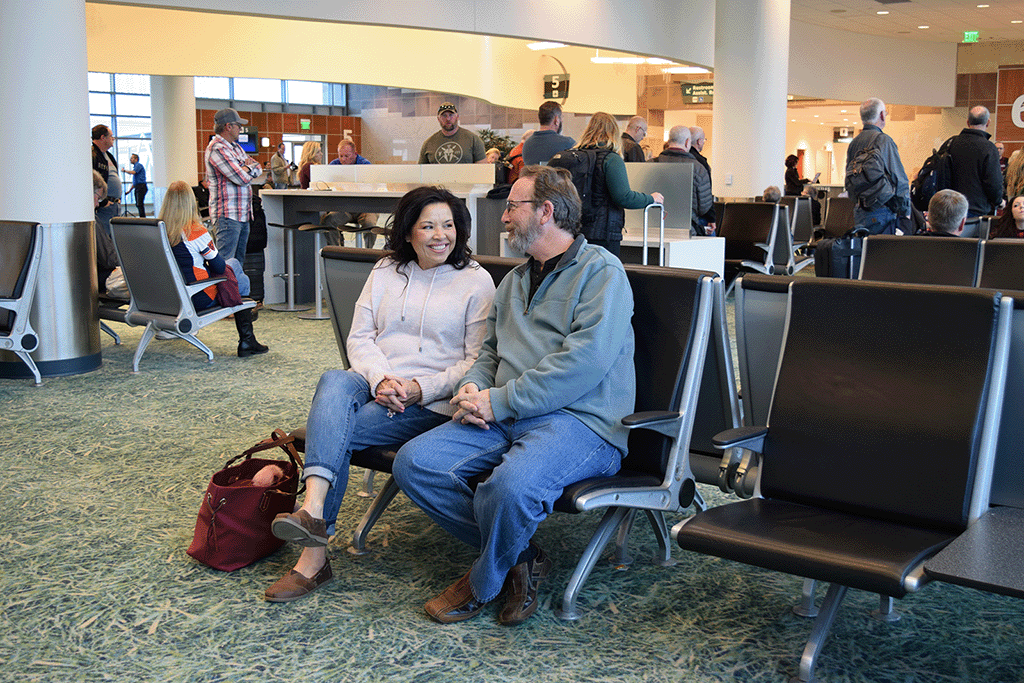Just over six months into 2023, and it looks like the Springfield-Branson National Airport is on its way to shattering 2019 records, moving past some of the impacts of the pandemic while embracing others.
Passenger traffic, fuel sales, checkpoint screenings and operations, among other components of the airport, are all up in Springfield despite the issues that continue to plague the airline industry.
“It looks like 2023 is going to be a truly breakout year for the airport, where we really put the pandemic behind us,” said Kent Boyd, the public information and marketing manager at the Springfield-Branson National Airport.
Data indicates business up across airport
While passenger traffic and enplanements at the Roy Blunt Terminal are among the primary ways to gauge Springfield’s bustling air travel, multiple data points reflect that the airport is well on its way to a record year.
As of June 15, fuel sales are up 12.5 percent year-to-date, according to Brian Weiler, the director of aviation at the airport.
The airport’s parking lots are nearing capacity, with a day in early June seeing 2,170 cars in 2,630 available spaces.
“If this trend continues, we're gonna have to be doing something about parking, probably before long,” Boyd said.
At the June 15 Airport Board meeting, Boyd said that single-day checkpoint screenings shattered previous records, with TSA screening 2,600 people a few weeks prior, well above a previous high of about 1,900.
Boyd later said that about 2,300 screenings a day had recently become “typical.”

Between January and May, passenger traffic was up 10.5 percent over the same period last year. 2019 still holds the record for total numbers of passengers, at 1,187,068. Based on projections presented on June 15, Boyd estimates that number to hit somewhere around 1,276,000 this year.
“It could be higher, could be lower, but that's ballpark,” Boyd said. “We’ll be very close to 1.3 million, I think.”
Projections of enplanements, which refers to passengers who are boarding planes, are established in the airport’s Master Plan, which was last published in 2011. From 2015 through 2019, actual enplanements were above the forecasted amount.
Of course, in 2020 and 2021 overall passenger traffic, including enplanements, was down. For the first time since 2019, last year’s actual enplanements narrowly exceeded 2011 projections as passenger traffic inched closer to 2019 levels. If these trends continue, the airport could easily exceed its projections for this year.
New forecasts are going to be made in the next 12 to 18 months, as the new master planning process begins.
Weiler told board members that the airport’s operations, which refers to total takeoffs and landings, were 19 percent ahead of last year’s at this time. This was spurred, in large part, by the Premier Flight Center training program, with 77 students enrolled in the airport flight school in the fall. Additionally, Springfield Public Schools’ new Fly SPS program, through a partnership between the Premier Flight Center and Ozarks Technical Community College, is training 10 high school students.

Traffic reflective of local economy, post-pandemic priorities
Boyd, who has been with the airport since 2006, said passenger numbers typically reflect economic activity in the metropolitan area, and that became especially clear to him during the Great Recession.
“Airport traffic, regardless of what airport we're talking about, is a leading economic indicator, meaning it’s foreshadowing what's going on, what's going to happen in the economy by a financial quarter or two,” he said.
Like air travel, sales tax revenues in Springfield remain high, with slowed growth anticipated in the year ahead.
While Boyd conceded to the board members that there were always unknowns, evidenced by inflation and labor and aircraft shortages, he said that there are generally no major concerns in the industry right now. Despite continued concerns of another recession, airlines continue to book, and the Springfield airport continues to be busy.
“When it comes to air travel, [people are] spending,” Boyd told the Hauxeda. “So that tells me a couple of things — it tells me the economy is doing really well, and I think it also is part of the psychological impact of COVID.”
The psychological impact Boyd was referring to, one where people have sought to strike a better balance post-COVID between their work life and home life, has led to a boom in bleisure (business + leisure) travel.
Prior to the pandemic, business travel made up over half of airlines’ revenue, according to Boyd, but has yet to return to those same levels. Boyd attributed the rise in bleisure travel as a reason for the Springfield airport’s now-busy Tuesdays and Wednesdays.
“Prior to this year and late last year, Tuesday was always the deadest day here, and it perhaps still is, but it's noticeably more crowded, I think, than it was,” he said.

Increasing traffic could provide opportunities, prompt needs
The increase in demand for air travel, and the seasonal ebbs and flows, has allowed the Springfield airport to explore additional flights and add more frequent flights to certain destinations and to new cities.
In September, American Airlines will add a daily flight from Springfield to Dallas and Charlotte, according to Boyd, despite it essentially being the end of the summer travel season.
“That's how confident American is that they're gonna be able to fill the planes here in Springfield. That’s a good sign for our market,” he said.
Additionally, Boyd said Springfield has a strong case to add a flight to Washington, D.C., and a new flight to Denver is a possibility.
With these added flights and new opportunities come new challenges for the Springfield airport.
Boyd said the airport has, for the most part, been able to avoid any operational issues, but some could arise as business increases, such as the parking lot nearing capacity. At one point prior to the pandemic, Boyd said they ran out of parking spaces, resulting in vehicles being parked in the grass. That demand resulted in an expansion of the airport’s economy parking lot.
“We were within 500 or 600 spots of being at capacity,” Boyd said. “There's a margin there, but what that tells us is that if this kind of growth continues over the next two or three years, we're not going to have capacity in three or four years. So, we have to start thinking now about how we're going to address that, and that's really been one of our biggest challenges.”
While continued growth is expected, so is a flattening or even a decrease at some point in the future.
“That's the reality of airport life,” Boyd said. “It tends to come in growth spurts.”
With advance summer booking, he anticipates that growth spurt to at least continue in the short term, potentially spurring the Springfield-Branson National Airport to its busiest year ever.


